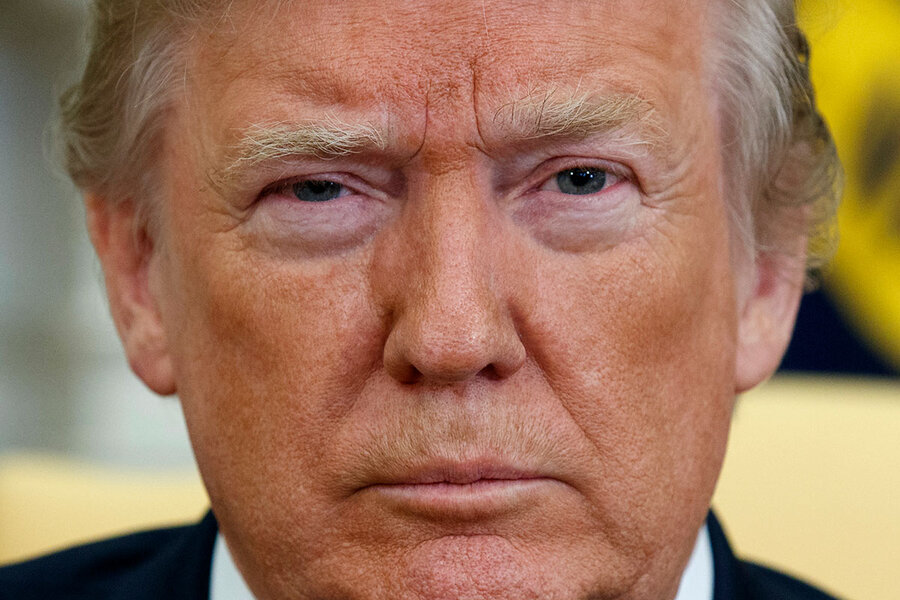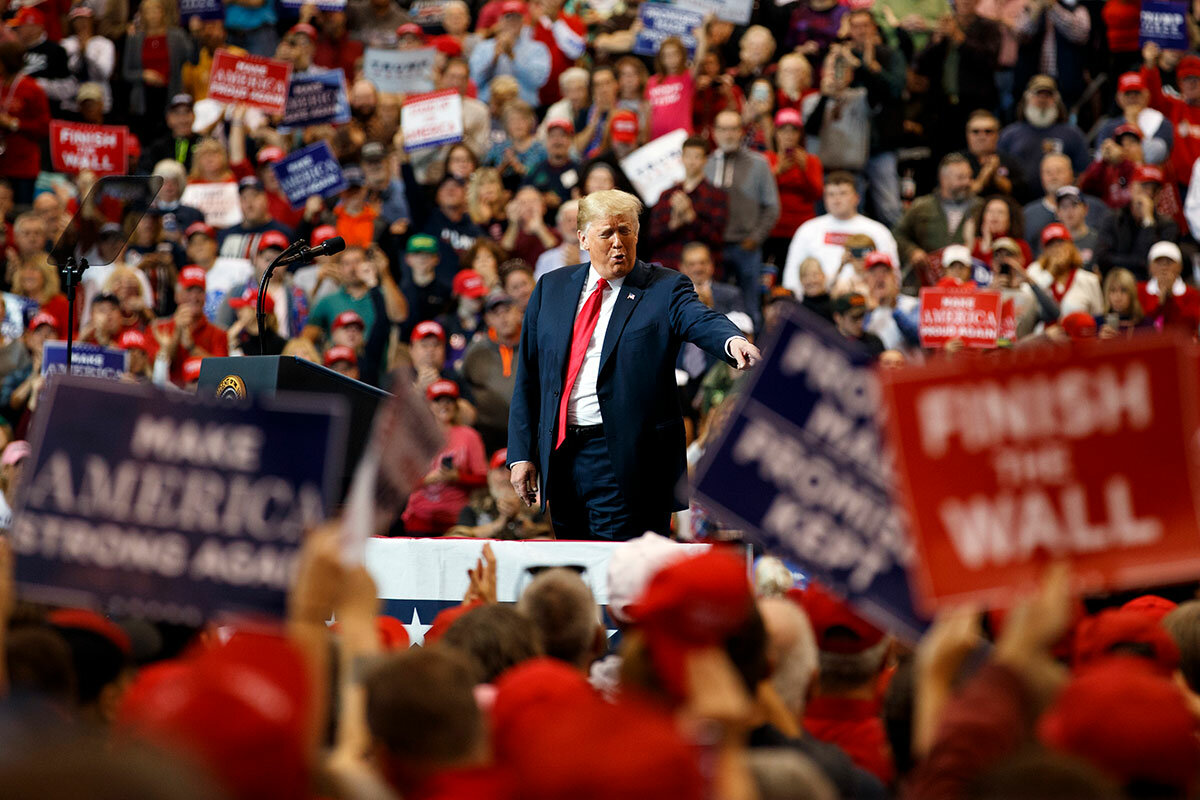The Trump effect at two: Have views of an unconventional presidency shifted?
Loading...
| Washington
From the start, Donald Trump has tested a “chaos theory” of the American presidency.
Countless norms of a modern White House have vanished, as the ultimate outsider chief executive has done things his way. President Trump has churned through top advisers and Cabinet secretaries at a record pace, dramatically changed the form and content of presidential communications, embraced the politics of government shutdowns, and announced breathtaking policy shifts that have caught even senior aides and world leaders off guard.
A year that began with a short shutdown ended with a long, partial one, as Mr. Trump blew up Congress’s plan to extend funding for a quarter of the government over funding for a Southern border wall.
Why We Wrote This
Supporters see his norm-busting approach as good for the country at the same time that critics view it as dangerously unstable. Is he sowing chaos or being unconventionally effective?
From the profoundly important to the trivial, Year Two of the Trump presidency matched Year One for sheer drama. Five former Trump aides faced prison time in matters both related and unrelated to the inquiry into Russian meddling in the 2016 election. A Supreme Court nomination merged with the #MeToo movement into must-see TV. Trump barnstormed the country to boost Republicans – and his 2020 prospects – but a blue wave flipped the House, setting up a potential collision course in 2019.
Then there’s the spectacle of a top Trump adviser’s spouse – George Conway, conservative lawyer and husband of Kellyanne Conway – regularly tweeting harsh criticisms of the president. Weird? Yes. But we’ve gotten used to it. We also barely blink, it seems, at news reports that might have engulfed other White Houses, such as hush money payments to mistresses and The New York Times’ year-long investigation into Mr. Trump’s family wealth. To the president’s supporters, it’s all more “fake news” or at best a sideshow; to opponents, it’s just more evidence of outrageous business as usual.
In the Trump era, the abnormal has come to feel normal. But to say that invites a backlash from the president’s critics, who have warned from Day One against “normalization,” a way station to acceptance, they say.
“Even the instability is coming to feel stable, because it is now so accepted,” says Barbara Perry, a presidential historian at the University of Virginia, Charlottesville.
No wonder “House of Cards” and “Veep” have folded. The most fertile imagination of TV writers scripting over-the-top fictional presidencies can’t compete with reality.
And yet …
There’s another way to look at this presidency.
Trump has, controversially or not, gotten a lot done using the legitimate levers of power, either by going through Congress or through executive action. He has changed the tax code, eliminated key elements of the Affordable Care Act, pulled the United States out of major international agreements (Paris climate accord, Iran nuclear deal), reformed others (US-Mexico-Canada trade), gone hard after China’s trade practices, and announced a pullout of all US troops from Syria and a drawdown from Afghanistan.
Consider also the economy – still strong on the fundamentals, despite the year-end plunge in the markets. In a Monitor interview, former GOP House Speaker Newt Gingrich says Trump’s reelection depends on both continued economic strength and working with the newly empowered Democrats in Congress.
“Part of it is, just keep the economy growing, and have people realize that on balance, their lives are dramatically better,” says Mr. Gingrich, an informal Trump adviser. (See sidebar for more of our interview.) “Part of it is, focus on common-sense solutions on health care, and a bipartisan approach on infrastructure.”
Ari Fleischer, former press secretary in the second Bush White House, sees another imperative heading into 2020: outreach to minorities, who went heavily against Trump in 2016.
“The way he expands his base is by talking and showing that he cares about people who don’t come to his rallies,” Mr. Fleischer says.
Whether these measures are even available to Trump, after two years of tumult and no-holds-barred rhetoric, is debatable. Add to that the sirens coming from the left warning of Trump as a wannabe autocrat. “I alone can fix it,” candidate Trump thundered at the GOP’s 2016 convention. As president, now a self-described “nationalist,” he routinely praises the iron-fisted rule of strongmen the world over, from North Korea and China to Russia, Turkey, and the Philippines.
The Brennan Center for Justice at New York University warns of the “extraordinary authority” Trump has available to him – 136 emergency powers “from the minor to the catastrophic,” including seizing control of the internet and declaring martial law.
But so far, at least, the reality of Trump’s executive actions hasn’t matched the fears.
“His rhetoric does reflect an excessive view of inherent power,” says Jonathan Turley, a constitutional law scholar at George Washington University. “But he hasn’t actually used it.”
Trump’s use of executive power is in line with that of his predecessors, Mr. Turley says. And when Trump’s unilateral actions have been reined in by judges – such as the so-called ban on immigration to the US from some predominantly Muslim countries – his administration has followed the edicts of the courts.
“He has given no indication that he is prepared to defy judicial authority,” says Turley. “And he hasn’t ordered agencies to ignore judicial orders. So thus far, he does not have a record that raises the specter of authoritarianism.”
Furthermore, Trump has even managed, on occasion, to preside over significant policy reform with strong bipartisan support in Congress. On Dec. 21, he signed the First Step Act, criminal justice reforms that are deemed modest but nevertheless represent the most significant changes to the system in decades, including scaling back mandatory minimum sentences for nonviolent drug felons. Trump and his senior adviser son-in-law Jared Kushner had pushed hard for the bill in the face of conservative resistance.
Yet on that very same day, Trump also presided over the start of the third government shutdown of the year – this one partial, but by far the longest – when he held firm on demanding more than the Democratic position of $1.3 billion to add more barrier structures to the US-Mexico border.
Two years in, the first American ever to assume the presidency with no governing or military experience seems as untethered by convention as ever – using the levers of power at his disposal, taking stands on his core issues (immigration, trade), and bucking hard-line conservatives when it suits him (criminal justice reform).
There is little that’s routine about this presidency, but a certain rhythm has set in. Quiet days are followed by bursts of activity and provocative tweets, like the programming of a TV drama. His ever-shifting cast of advisers has learned to let Trump be Trump, because they have no choice.
And along the way, this president has had a profound impact on the country.
At the barber shop
Ron Miller – provider of “fantastic haircuts,” by his own reckoning – used to serve a politically diverse clientele at his one-chair barber shop in rural Greene, Maine. Then Trump got elected. Now, Mr. Miller says, people who disagree with his conservative politics don’t come to his shop anymore – even customers of 20 years’ standing.
“I’ve been told, ‘I’m not going to support you because you’ve supported President Trump,’ ” says Miller, a retired Navy diver with a bushy horseshoe mustache. His walls are crammed with memorabilia, including two stuffed deer heads, a Bush poster, and a well-worn Make America Great Again cap.
“You can’t be a Democrat or you can’t be a Republican and have an opinion without the other person hating you,” Miller says. “I’ve seen people in the town that don’t talk to each other anymore.”
Just an hour south, in Maine’s largest city, Portland, it’s not hard to find folks from the other side of the divide. Lynn Jennings and David Silk, just finished with a long morning bike ride, have nothing good to say about the Trump administration as they sip coffee in a local cafe.
“Two years down, two to go,” says Ms. Jennings, a former Olympic runner. “Every day feels like it’s worse than the day before.”
Mr. Silk, a lawyer, recalls coming of age during the Nixon era, and how the president used the tools of government to do away with opponents. “Growing up in that time, I had a distrust of government,” he says. “It took a long time to get that trust back. And now” – he snaps his fingers – “it’s gone again, just like that.”
The two Maines – a predominantly liberal coast, a conservative-leaning interior – reflect a national divide that Trump has exacerbated but did not create. In their new book “Identity Crisis,” political scientists John Sides, Michael Tesler, and Lynn Vavreck conclude from survey data that the American public contains “reservoirs of sentiment that serve both to unify and to divide.” And in 2016, it was the polarizing rhetoric of the presidential candidates that sowed division among voters in their communities.
“What gave us the 2016 election, then, was not changes among voters. It was changes in the candidates,” the authors write.
Trump’s scorched-earth rhetoric dominated the campaign and activated a new coalition of traditional conservatives and white working-class voters. But Democratic nominee Hillary Clinton didn’t help when she labeled half of Trump supporters “a basket of deplorables.”
Americans, in fact, agree on much when it comes to defining national identity. A December 2016 survey by the bipartisan Democracy Fund found that American identity is centered on beliefs, not race or religion. Most Democrats and Republicans agreed, for example, that “respecting American political institutions and laws” and “accepting diverse racial and religious backgrounds” were important to being American.
But since Trump’s election, Americans’ views on immigration have grown more polarized. Take the question of whether unauthorized immigrants should have a path to citizenship, provided they meet certain requirements. Since 2013, Democrats have held steady in their support of this view (77 percent), as have independents (66 percent), says Robert Jones, chief executive officer of the Public Religion Research Institute.
PRRI’s numbers among Republicans present a different picture: Until late 2016, GOP voters’ support for a path to citizenship held consistently around 55 percent, then between 2016 and 2018, support dropped to 39 percent. Republican support for deportation has jumped from 28 percent to 42 percent.
“On that question, there is no other explanation than the presidency of Donald Trump,” says Dr. Jones. “I don’t believe Trump invented the conditions; racial tensions and anti-immigrant feeling were latent, and he brought them to the foreground.”
Jones also posits that the ascendance of Trump represents a profound shift in the definition of America’s “culture wars.”
“In 2004, we were talking abortion and same sex marriage,” he says. “Today, those kind of issues have been nearly replaced by identity questions: who gets to be an American, who doesn’t, what it means to be an American.”
Ask Trump voters open-ended questions about how he’s doing, and they often point to the economy first, then immigration, trade, and court picks, all happily. Any complaints? The tweets. The mouth. How his brash style can step on good news and hurt his own cause. But even there, the message is mixed: Yes, he could dial it back on Twitter, but they like hearing directly from the president. And it’s the media’s fault that he’s not popular, and Congress’s fault that he can’t enact his agenda.
“As things evolved, I think the economy seems to be doing well,” despite the downturn in the markets, says Joseph Rattay, a commercial banker in Cleveland. “He’s trying to make good on his promises with border security. He’s making headway with good trade agreements…. Overall, he’s trying to do what he campaigned on.”
Karen Kramer, a software developer from north of Columbus, Ohio, says she was leaning toward someone else in the 2016 GOP primaries but came to like Trump.
“I do feel like he speaks from the heart and that he’s really trying to do the best for our country,” says Ms. Kramer.
She also sees a religious dimension to the Trump presidency, and likes that he’s trying to “preserve a bit of the culture.”
“I am tolerant of other religions, but I also feel like my faith and the Christian religion have really been oppressed, actually,” she says. “I feel just glad that he’s willing to say openly that he believes in God or that he’s celebrating Christmas.”
The view from Caldwell Farms
Rural Androscoggin County in Maine, which includes the town of Greene, is in a way emblematic of the Trump revolution. In 2012, all but four towns in the county voted to reelect President Barack Obama. In 2016, all but one town voted for Trump.
It’s not hard to find satisfied residents. Ralph Caldwell, a farmer in Turner, says businesses here are more optimistic and expanding. “Just look at Caldwell Farms,” he says. “We’re selling more beef than we were, and we’re buying more replacement cattle than we were…. Folks who work for a living, we think he’s wonderful.”
Mr. Caldwell’s only complaint about Trump is that he has “let [special counsel Robert] Mueller stay around. He should have shut off their funds.”
Over in Lisbon Falls, four women friends are gathered at Chummy’s Diner for their monthly breakfast, and are eager to talk politics with a visiting reporter.
“The economy is better,” says Karen Hanlon, who worked the polls on Election Day. “Unemployment is so low. I just wish he’d do more about immigration, but his hands are tied.”
Her friend Monique Gayton also strongly supports Trump, but wishes he would “put a zipper on his mouth.” Still, she and her friends believe the media has been too hostile to the president. Fox is the only network that’s been supportive, Ms. Gayton says, and “if CNN could put a dagger in his throat, they’d do it.”
Public opinion hasn’t budged
One remarkable aspect of the Trump presidency, a roller-coaster ride of “did that really just happen?” moments, is the stability of public opinion. From the start, Trump’s average job approval rating in major polls has consistently held between the high 30s and mid-40s, with disapproval in the low to mid-50s.
“Most people were locked in in their views of Trump, pro or con, from Day One – really even before – and they still are,” says Carroll Doherty, director of political research at the Pew Research Center.
Trump, in fact, is the most politically polarizing president of any going back to Dwight Eisenhower, based on survey data from Pew and Gallup. In the first 19 months of Trump’s presidency, he has averaged 84 percent support among Republicans and 7 percent support among Democrats in Pew polls.
Beyond ever-greater polarization, Americans are also more likely to say that political conversations with people they disagree with are “stressful and frustrating” – and the change is largely among Democrats.
“The worst thing about his presidency is that he has given people permission to be their worst, to be horrible,” says Tasha Judson, a hairdresser and Millennial who grew up in coastal Maine.
In Boston, several African-Americans interviewed agree with Ms. Judson’s assessment. “He opened a can that can’t be closed. When Obama was in office we didn’t have any of this – any of this toward black people or immigrants,” says Candy, who asked that her last name not be used.
Eddy Remy says “politics is politics,” but he objects to the president treating the White House like a reality TV set. “He thinks it’s all a game. He thinks this is ‘The Apprentice.’ ”
In the press room
Time was when White House reporters could count on a press briefing three or four times a week – even in the Trump era. It was an opportunity to question the press secretary about the issues of the day.
In mid-2018, that all changed. The frequency of direct communication from Trump increased – tweets, short question and answer sessions with reporters, and media interviews. The daily briefing nearly vanished.
“If you can hear directly from the president and the press has a chance to ask the president of the United States questions directly, that’s infinitely better than talking to me,” press secretary Sarah Sanders told Fox News in September.
White House reporters and scholars on presidential communications disagree.
“We’ve definitely lost something by losing the daily briefing,” says Martha Joynt Kumar, who studies White House-media relations from her perch in the West Wing press area.
Reporters have lost the regular opportunity to put their questions, on the record, to the press secretary in public, she says. And the White House has lost a valuable source of intelligence on what the press – and by extension the public – is clamoring to know.
“It’s useful for the press secretary in dealings with the president and with staff,” says Ms. Kumar, an emeritus political science professor at Towson University in Maryland. “It can help the press secretary uncork information from the inside. A press secretary can say, ‘Look, I’m getting a lot of questions on that.’ ”
In a way, Trump has become his own press secretary, just as he has made the job of White House chief of staff even tougher than usual, by chafing at the order a typical chief tries to impose. These are among the new norms of the Trump era.
In front of the lectern
“This is what Washington looks like when you have a president who refuses to sort of go along to get along.”
That’s acting White House chief of staff Mick Mulvaney speaking on Fox News soon after the latest government shutdown began. But it’s an observation that can apply widely. Trump does things his own way – including an unorthodox approach to facts and the norms of public civility.
Still, Trump also regularly demonstrates behavior that is conventionally “presidential.” For example, he showed compassion toward the families of young shooting victims at a recent White House meeting to unveil the report of his school safety commission.
But “President acts presidential” isn’t a headline. “President calls porn star ‘Horseface’ ” is. Some media’s emphasis on the negative and outrageous can skew coverage. Trump supporters focus on outcomes and tolerate or minimize his style.
“Separate the signal from the noise,” former Trump aide Steve Bannon often advises.
Trump critics see the power of the presidential bully pulpit and its potential (or actual) harm to overall public discourse.
How much Trump bears blame for a wider decline in public civility – a trend that was already well under way when he entered politics – is open to debate.
“It’s an important question,” says Kathleen Hall Jamieson, director of the Annenberg Public Policy Center at the University of Pennsylvania. “The presumption is, someone who gains a great deal of national exposure and carries the legitimacy of the presidency has the capacity to normalize something.”
Trump’s rhetoric at rallies and in tweets certainly strays, at times, from the norms of acceptable public discourse – and rally-goers at times follow suit. But in the 2018 midterms, there was no evidence that major candidates were able to duplicate Trump’s style with success.
“We haven’t seen [Trump’s style] spawn successful imitators, and that’s good news” for the norms of political rhetoric, Ms. Jamieson says. And despite Trump’s perpetual cries of “fake news,” public trust in media rebounded in 2018, according to polls by Gallup and the Poynter Institute.
Looking ahead to the campaign trail
Both Gingrich and Fleischer are avatars of a Republican Party that no longer exists. And both, in their own way, are trying to help shape the party’s future.
Gingrich, who speaks with Trump regularly, preaches his own version of “The Art of the Deal” – compromise with Democrats where possible, and let lawyers deal with the investigations.
The former speaker says he’s told Trump “some of his tweets don’t help him at all.” But “he’s been very effective on big things.”
Fleischer seems less sanguine about 2020. “Trump is not positioned well,” says Fleischer, co-author of a 2013 GOP report on the party’s future.
He agrees that the new House Democratic majority gives Trump a convenient punching bag. And the Democrats certainly might overdo it on investigations and impeachment, and move “too far left” in their presidential nomination process, he says. But Fleischer sees the drubbing Republicans took in the midterms as a warning sign for 2020, because of what it showed about GOP weakness with women and minorities.
The numbers on race are stark, as Fleischer laid out in a recent op-ed at FoxNews.com: In 2000, when George W. Bush was first elected, 81 percent of American voters were white. In 2016, the figure was 71 percent. By 2020, it will be even lower.
“Every successful politician maximizes their base, gins up turnout from their base, and then adds to it,” Fleischer says in an interview. “Trump’s done two of the three.”
But given his style, can Trump really hold his base and attract new support at the same time?
“That was the point of my op-ed,” says Fleischer. “He has to figure out how to do both or it won’t be enough.”
Staff writer Story Hinckley contributed to this report from Maine and Boston. Christopher Johnston contributed from Ohio.










